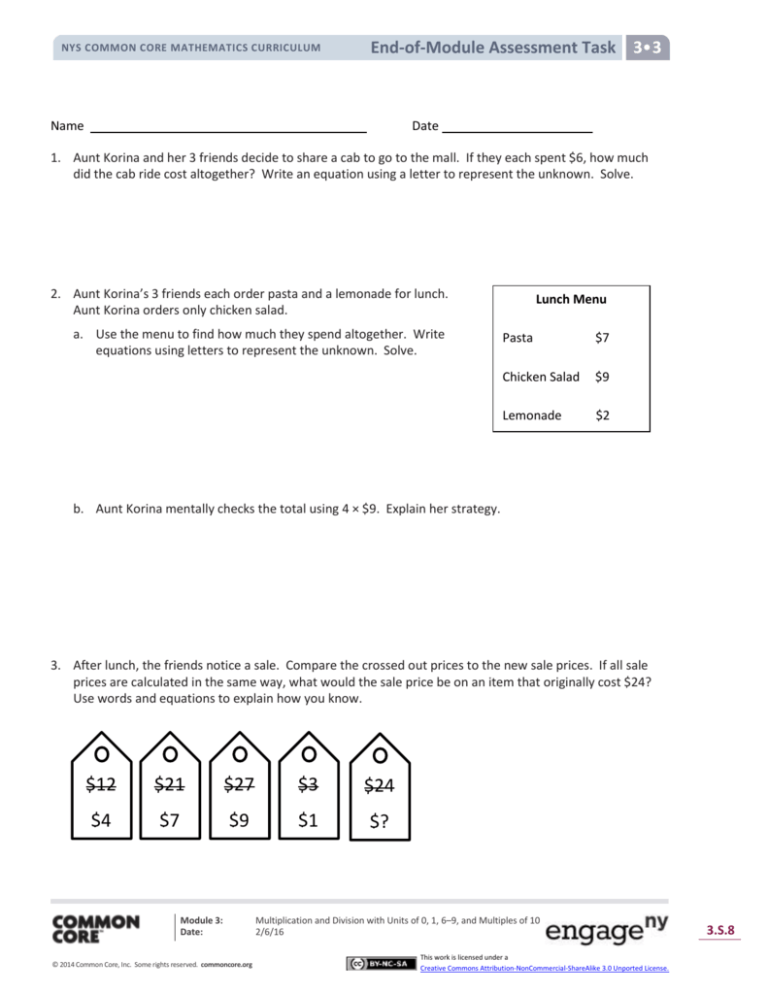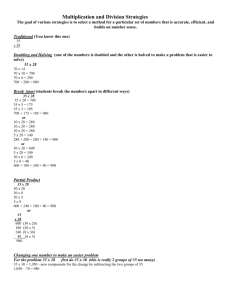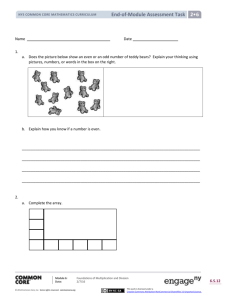
NYS COMMON CORE MATHEMATICS CURRICULUM
3•3
End-of-Module Assessment Task Lesson
2•3
Name
Date
1. Aunt Korina and her 3 friends decide to share a cab to go to the mall. If they each spent $6, how much
did the cab ride cost altogether? Write an equation using a letter to represent the unknown. Solve.
2. Aunt Korina’s 3 friends each order pasta and a lemonade for lunch.
Aunt Korina orders only chicken salad.
a. Use the menu to find how much they spend altogether. Write
equations using letters to represent the unknown. Solve.
Lunch Menu
Pasta
$7
Chicken Salad
$9
Lemonade
$2
b. Aunt Korina mentally checks the total using 4 × $9. Explain her strategy.
3. After lunch, the friends notice a sale. Compare the crossed out prices to the new sale prices. If all sale
prices are calculated in the same way, what would the sale price be on an item that originally cost $24?
Use words and equations to explain how you know.
$12
$21
$27
$3
$24
$4
$7
$9
$1
$?
Module 3:
Date:
© 2014 Common Core, Inc. Some rights reserved. commoncore.org
Multiplication and Division with Units of 0, 1, 6–9, and Multiples of 10
2/6/16
This work is licensed under a
Creative Commons Attribution-NonCommercial-ShareAlike 3.0 Unported License.
3.S.8
NYS COMMON CORE MATHEMATICS CURRICULUM
3•3
End-of-Module Assessment Task Lesson
2•3
4. a. A shopkeeper in the bookstore arranges the boxed sets of books as shown to the right. If each box
contains 9 books, how many books are there?
Write an equation using a letter to represent the unknown, and then
solve.
Explain how you know your answer is reasonable.
b. Aunt Korina figures out how many books are in the arrangement. Her work is shown below. Explain
Aunt Korina’s strategy.
10 × 10 – 10 = 90
c. In the book store, Aunt Korina buys 3 boxes of pens. Each box contains 2 bundles of 10 gray pens.
Her friend buys 6 packs of pens. Each pack contains 10 black pens. Explain how the equation below
shows how Aunt Korina and her friend buy the same number of pens.
6 × 10 = 3 × 2 × 10
Box of gray pens
Module 3:
Date:
© 2014 Common Core, Inc. Some rights reserved. commoncore.org
Pack of black pens
Multiplication and Division with Units of 0, 1, 6–9, and Multiples of 10
2/6/16
This work is licensed under a
Creative Commons Attribution-NonCommercial-ShareAlike 3.0 Unported License.
3.S.9
NYS COMMON CORE MATHEMATICS CURRICULUM
3•3
End-of-Module Assessment Task Lesson
2•3
5. Complete as many problems as you can in 100 seconds. The teacher will time you and tell you when to
stop.
Module 3:
Date:
© 2014 Common Core, Inc. Some rights reserved. commoncore.org
Multiplication and Division with Units of 0, 1, 6–9, and Multiples of 10
2/6/16
This work is licensed under a
Creative Commons Attribution-NonCommercial-ShareAlike 3.0 Unported License.
3.S.10
NYS COMMON CORE MATHEMATICS CURRICULUM
3•3
End-of-Module Assessment Task Lesson
2•3
End-of-Module Assessment Task
Standards Addressed
Topics A–F
Represent and solve problems involving multiplication and division.
3.OA.3
Use multiplication and division within 100 to solve word problems in situations involving
equal groups, arrays, and measurement quantities, e.g., by using drawings and equations
with a symbol for the unknown number to represent the problem.
3.OA.4
Determine the unknown whole number in a multiplication or division equation relating
three whole numbers. For example, determine the unknown number that makes the
equation true in each of the equations 8 × ? = 48, 5 = _ ÷ 3, 6 × 6 = ?.
Understand properties of multiplication and the relationship between multiplication and division.
3.OA.5
Apply properties of operations as strategies to multiply and divide. (Students need not use
formal terms for these properties.) Examples: If 6 × 4 = 24 is known, then 4 × 6 = 24 is also
known. (Commutative property of multiplication.) 3 × 5 × 2 can be found by 3 × 5 = 15,
then 15 × 2 = 30, or by 5 × 2 = 10, then 3 × 10 = 30. (Associative property of multiplication.)
Knowing that 8 × 5 = 40 and 8 × 2 = 16, one can find 8 × 7 as
8 × (5 + 2) = (8 × 5) + (8 × 2) = 40 + 16 = 56. (Distributive property.)
Multiply and divide within 100.
3.OA.7
Fluently multiply and divide within 100, using strategies such as the relationship between
multiplication and division (e.g., knowing that 8 × 5 = 40, one knows 40 ÷ 5 = 8) or
properties of operations. By the end of Grade 3, know from memory all products of two
one-digit numbers.
Solve problems involving the four operations, and identify and explain patterns in arithmetic.
3.OA.8
Solve two-step word problems using the four operations. Represent these problems using
equations with a letter standing for the unknown quantity. Assess the reasonableness of
answers using mental computation and estimation strategies including rounding.
(This standard is limited to problems posed with whole numbers and having wholenumber answers; students should know how to perform operations in the conventional
order when there are no parentheses to specify a particular order, i.e., Order of
Operations.)
3.OA.9
Identify arithmetic patterns (including patterns in the addition table or multiplication
table), and explain them using properties of operations. For example, observe that 4
times a number is always even, and explain why 4 times a number can be decomposed into
two equal addends.
Use place value understanding and properties of operations to perform multi-digit arithmetic. (A
range of algorithms may be used.)
3.NBT.3
Multiply one-digit whole numbers by multiples of 10 in the range 10–90 (e.g., 9 × 80,
5 × 60) using strategies based on place value and properties of operations.
Module 3:
Date:
© 2014 Common Core, Inc. Some rights reserved. commoncore.org
Multiplication and Division with Units of 0, 1, 6–9, and Multiples of 10
2/6/16
This work is licensed under a
Creative Commons Attribution-NonCommercial-ShareAlike 3.0 Unported License.
3.S.11
NYS COMMON CORE MATHEMATICS CURRICULUM
3•3
End-of-Module Assessment Task Lesson
2•3
Evaluating Student Learning Outcomes
A Progression Toward Mastery is provided to describe steps that illuminate the gradually increasing
understandings that students develop on their way to proficiency. In this chart, this progress is presented
from left (Step 1) to right (Step 4) for Problems 1–4. The learning goal for each student is to achieve Step 4
mastery. These steps are meant to help teachers and students identify and celebrate what the student CAN
do now and what they need to work on next. Problem 5 is scored differently since it is a timed assessment of
fluency. Students complete as many problems as they can in two minutes. Although this page of the
assessment contains 40 questions, answering 30 correct within the time limit is considered passing.
A Progression Toward Mastery
Assessment
Task Item
and
Standards
Assessed
1
3.OA.3
3.OA.4
2
3.OA.3
3.OA.4
3.OA.8
STEP 1
Little evidence of
reasoning without
a correct answer.
STEP 2
Evidence of some
reasoning without
a correct answer.
STEP 3
Evidence of some
reasoning with a
correct answer or
evidence of solid
reasoning with an
incorrect answer.
(3 Points)
STEP 4
Evidence of solid
reasoning with a
correct answer.
(1 Point)
(2 Points)
Student is unable to
write and solve an
equation.
Student writes a
multiplication equation
using the incorrect
factors and without a
letter to represent the
unknown.
Student writes a
multiplication equation
using a letter to
represent the unknown
but calculates an
incorrect answer (e.g.,
4 × $6 = n; n = wrong
answer).
The student correctly:
Student is unable to
answer either question
correctly.
Student attempts to
solve Part (a) but does
not use letters to
represent the
unknown.
Student writes correct
equations and solves
for the unknown in Part
(a) (e.g., F = the amount
in dollars spent by Aunt
Korina’s friends, K = the
amount in dollars spent
by Aunt Korina,
F + K = $27 + $9 = $36),
but provides inaccurate
explanation in Part (b).
The student correctly:
(4 Points)
Writes and solves
4 × $6 = n; n = $24.
Writes equations
using letters to
represent the
unknown (e.g.,
F = the amount in
dollars spent by Aunt
Korina’s friends,
K = the amount in
dollars spent by Aunt
Korina
F + K = $27 + $9 = $3
6).
Finds the total, $36,
in Part (a).
Provides accurate
explanation of
strategy in Part (b).
Module 3:
Date:
© 2014 Common Core, Inc. Some rights reserved. commoncore.org
Multiplication and Division with Units of 0, 1, 6–9, and Multiples of 10
2/6/16
This work is licensed under a
Creative Commons Attribution-NonCommercial-ShareAlike 3.0 Unported License.
3.S.12
NYS COMMON CORE MATHEMATICS CURRICULUM
3•3
End-of-Module Assessment Task Lesson
2•3
A Progression Toward Mastery
3
3.OA.9
4
3.OA.3
3.OA.4
3.OA.5
3.OA.8
3.OA.9
3.NBT.3
Student is unable to
find and explain the
pattern.
Student is unable to
answer any question
correctly.
Student attempts to
find and explain the
pattern.
Student answers one
question correctly.
Student understands
how the sale prices are
calculated but
incorrectly finds the
sale price of $24 (e.g.,
$24 ÷ 3 = wrong
answer).
The student clearly:
Student answers two
questions correctly.
Mistakes may include:
The student clearly:
Providing inaccurate
explanations in Parts
(a) or (b).
Provides accurate
explanation of the
equation in Part (a).
Inability to explain
why the equations
are equal in Part (c).
Provides accurate
explanation of the
9 = 10 – 1 pattern in
Part (b).
Explains the sale
prices are calculated
by dividing the
original price by 3.
Writes $24 ÷ 3 = $8.
Writes 10 × 9 = n;
n = 90 books.
Provides accurate
explanation of the
associative property
of multiplication in
Part (c) to find 60
pens altogether.
5
3.OA.7
Use the attached sample work to correct students’ answers on the fluency page of the assessment.
Students who answer 30 or more questions correctly within the allotted time pass this portion of the
assessment. For students who do not pass, you may choose to re-administer this fluency page with
each subsequent End-of-Module Assessment until they are successful.
Analyze the mistakes students make on this assessment to further guide your fluency instruction. Below
are possible questions to ask as you analyze:
Did this student struggle with multiplication, division, or both?
Did this student struggle with a particular factor?
Did the student consistently miss problems with the unknown in a particular position?
Module 3:
Date:
© 2014 Common Core, Inc. Some rights reserved. commoncore.org
Multiplication and Division with Units of 0, 1, 6–9, and Multiples of 10
2/6/16
This work is licensed under a
Creative Commons Attribution-NonCommercial-ShareAlike 3.0 Unported License.
3.S.13
NYS COMMON CORE MATHEMATICS CURRICULUM
Module 3:
Date:
© 2014 Common Core, Inc. Some rights reserved. commoncore.org
3•3
End-of-Module Assessment Task Lesson
2•3
Multiplication and Division with Units of 0, 1, 6–9, and Multiples of 10
2/6/16
This work is licensed under a
Creative Commons Attribution-NonCommercial-ShareAlike 3.0 Unported License.
3.S.14
NYS COMMON CORE MATHEMATICS CURRICULUM
Module 3:
Date:
© 2014 Common Core, Inc. Some rights reserved. commoncore.org
3•3
End-of-Module Assessment Task Lesson
2•3
Multiplication and Division with Units of 0, 1, 6–9, and Multiples of 10
2/6/16
This work is licensed under a
Creative Commons Attribution-NonCommercial-ShareAlike 3.0 Unported License.
3.S.15
NYS COMMON CORE MATHEMATICS CURRICULUM
Module 3:
Date:
© 2014 Common Core, Inc. Some rights reserved. commoncore.org
3•3
End-of-Module Assessment Task Lesson
2•3
Multiplication and Division with Units of 0, 1, 6–9, and Multiples of 10
2/6/16
This work is licensed under a
Creative Commons Attribution-NonCommercial-ShareAlike 3.0 Unported License.
3.S.16










